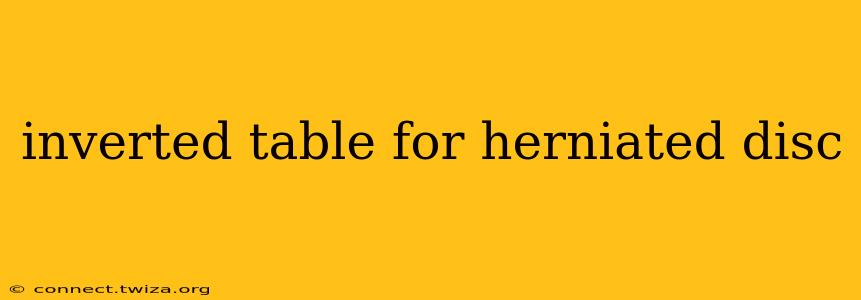A herniated disc, also known as a slipped or ruptured disc, occurs when the soft, gel-like center of an intervertebral disc pushes through a tear in the tougher outer layer. This can cause pain, numbness, tingling, and weakness in the back, neck, arms, or legs. Many people explore various treatment options, and the inverted table is one such method gaining popularity. But is it safe and effective? Let's dive in.
What is an Inverted Table?
An inverted table, also known as an inversion table or gravity boots, is a device that allows you to gently invert your body, hanging upside down at various angles. Proponents suggest that this inversion helps to decompress the spine, relieving pressure on herniated discs and potentially alleviating pain. The theory is that by reversing the gravitational pull, the spine stretches, creating space between the vertebrae.
Does an Inverted Table Help with a Herniated Disc?
This is a complex question with no simple yes or no answer. While some individuals report pain relief using an inverted table, the scientific evidence supporting its effectiveness for herniated discs is limited and inconclusive. Several small studies have shown some positive effects, but larger, more rigorous studies are needed to definitively confirm its benefits. The relief experienced might be temporary and vary significantly between individuals. Moreover, the mechanism by which inversion might help is not fully understood. It's crucial to remember that inversion doesn't actually heal the herniated disc; it might just temporarily alleviate symptoms.
What are the Risks of Using an Inverted Table?
Using an inverted table isn't without potential risks. These include:
- Increased Eye Pressure: Inversion can increase intraocular pressure (pressure within the eye), which could be problematic for individuals with glaucoma or other eye conditions.
- Headaches: Similar to increased eye pressure, inversion can trigger headaches in some people.
- High Blood Pressure: Individuals with high blood pressure should avoid inversion, as it can further elevate blood pressure.
- Dizziness and Nausea: The sudden change in blood flow can cause dizziness and nausea, especially in those unaccustomed to inversion.
- Muscle Strains: Improper use or overuse can lead to muscle strains.
- Neck Injuries: If not used correctly, an inverted table could potentially lead to neck injuries.
It's absolutely crucial to consult your doctor or physical therapist before using an inverted table, especially if you have any underlying health conditions. They can assess your individual situation and determine if inversion therapy is appropriate for you.
Can I use an inverted table if I have other health conditions?
Many health conditions could be exacerbated by inversion therapy. These include but are not limited to:
- Glaucoma: Increased intraocular pressure is a serious risk.
- High blood pressure (hypertension): Inversion can significantly increase blood pressure.
- Retinal detachment: This condition makes inversion extremely dangerous.
- Heart conditions: Inversion can stress the cardiovascular system.
- Pregnancy: The increased pressure on the abdomen and potential for falls make inversion unsafe during pregnancy.
- Recent surgery: Allow time for proper healing before considering inversion.
How long should I use an inverted table for?
There's no one-size-fits-all answer. Start with short sessions (e.g., a minute or two) and gradually increase the duration as tolerated, always listening to your body. Never exceed the manufacturer's recommendations.
What are the alternatives to an inverted table for herniated disc pain?
Many other effective treatments are available for herniated discs. These include:
- Physical therapy: Helps strengthen core muscles and improve posture.
- Medication: Pain relievers and anti-inflammatory drugs can manage pain and inflammation.
- Epidural steroid injections: Can reduce inflammation around the nerve roots.
- Surgery: In severe cases, surgery might be necessary.
Ultimately, the best approach for managing a herniated disc depends on individual circumstances and severity. It is vital to seek professional medical advice to determine the most appropriate and safe treatment plan. Self-treating can be risky and may delay proper medical care.
